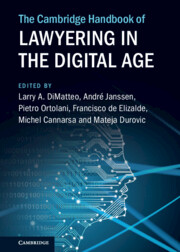Book contents
- The Cambridge Handbook of Lawyering in the Digital Age
- The Cambridge Handbook of Lawyering in the Digital Age
- Copyright page
- Contents
- Detailed Contents
- Figures
- Contributors
- Preface
- 1 Lawyering in the Digital Age
- Part I Effects of Technology on Legal Practice
- Part II Legal Tech and ADR
- 6 Legal Tech in ADR
- 7 A Blockchain-Based Smart Dispute Resolution Method
- 8 Digital Dispute Resolution
- Part III Legal Tech in Consumer Relations and Small Claims
- Part IV Legal Tech and Public Law
- Part V Legal Ethics and Societal Values Confront Technology
- Part VI Fate of the Legal Professions
8 - Digital Dispute Resolution
Blurring the Boundaries of ADR
from Part II - Legal Tech and ADR
Published online by Cambridge University Press: 18 November 2021
- The Cambridge Handbook of Lawyering in the Digital Age
- The Cambridge Handbook of Lawyering in the Digital Age
- Copyright page
- Contents
- Detailed Contents
- Figures
- Contributors
- Preface
- 1 Lawyering in the Digital Age
- Part I Effects of Technology on Legal Practice
- Part II Legal Tech and ADR
- 6 Legal Tech in ADR
- 7 A Blockchain-Based Smart Dispute Resolution Method
- 8 Digital Dispute Resolution
- Part III Legal Tech in Consumer Relations and Small Claims
- Part IV Legal Tech and Public Law
- Part V Legal Ethics and Societal Values Confront Technology
- Part VI Fate of the Legal Professions
Summary
Any discussion of alternative dispute resolution (ADR) necessarily relies on some basic, shared notions, allowing us to identify those procedures that are considered an alternative to litigation in national courts. When legal scholars refer to arbitration or mediation, for instance, they often take it for granted that those linguistic labels are sufficient to designate a certain procedure. To be sure, none of these labels have a monolithic quality: the word ‘arbitration’, for instance, designates a family of private adjudication phenomena, which can differ in significant ways. Each ADR mechanism, hence, is best understood as a spectrum of procedures. Nevertheless, all of the instances falling within that spectrum must necessarily have some shared broad-stroke feature, so that they can all (with an unavoidable degree of simplification) be referred to as arbitration, mediation or another ADR mechanism. In other words, there must necessarily be some boundaries that lawyers heuristically deploy to build a rough yet shared taxonomy of ADR.
- Type
- Chapter
- Information
- The Cambridge Handbook of Lawyering in the Digital Age , pp. 140 - 156Publisher: Cambridge University PressPrint publication year: 2021

